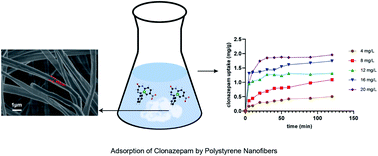Polystyrene nanofibers as an effective sorbent for the adsorption of clonazepam: kinetic and thermodynamic studies
Abstract
Polystyrene (PS) electrospun nanofibers were prepared via electrospinning for the adsorption of clonazepam from aqueous solution. The adsorption conditions such as adsorption time, solution pH and the amount of adsorbent were optimized. The adsorption kinetics and thermodynamic properties of clonazepam on PS nanofibers were studied under optimized conditions. The pseudo-second-order kinetic model can fit well the adsorption process of clonazepam on polystyrene nanofibers, indicating that the diffusion process in the fiber is the rate-limiting step of the adsorption process. The adsorption equilibrium data are in accordance with the Freundlich isotherm model, and the maximum adsorption capacity is 3.2 mg g−1. Thermodynamic studies revealed that the adsorption process is endothermic and spontaneous in nature. It was suggested that PS electrospun nanofibers have good potential for the separation and purification of clonazepam from a water-soluble matrix as a novel effective adsorbent material.



 Please wait while we load your content...
Please wait while we load your content...